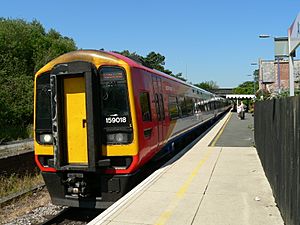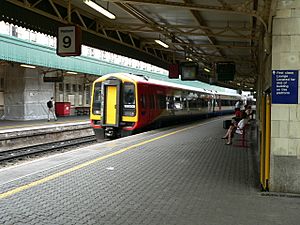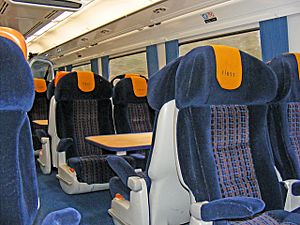British Rail Class 159 facts for kids
Quick facts for kids British Rail Class 159"South Western Turbo" |
|
|---|---|

Unrefurbished Class 159018 arrives at Axminster
|
|
| In service | 1992 - present |
| Manufacturer | BREL |
| Family name | Sprinter |
| Constructed | 1989 - 1993 |
| Refurbishment | 2000-2001, 2007-2008 (159/0) |
| Number built | 22 (159/0) 8 (159/1) |
| Number in service | 30 |
| Formation | 3 cars per trainset |
| Fleet numbers | 159001 - 159022, 159101 - 159108 |
| Operator(s) | South Western Railway |
| Line(s) served | West of England main line |
| Specifications | |
| Car length | 22.5 metres |
| Width | 2.7 metres |
| Maximum speed | 90mph |
| Weight | 37.8 tonnes |
| Traction system | Voith Hydraulic |
| Prime mover(s) | Cummins 400hp (159/0) Cummins 350hp (159/1) |
| Safety system(s) | AWS, TPWS |
| Track gauge | 1435 mm (4 ft 8½ in) |
The British Rail Class 159 is a special type of train called a "diesel multiple unit." This means it's a train that carries passengers and has its own engines built right into the carriages, so it doesn't need a separate engine to pull it. These trains were built between 1989 and 1993 by a company called BREL at their factory in Derby.
The Class 159 trains were given the nickname "South Western Turbo" by Network SouthEast, which was a train company back then. They are also part of a larger group of trains known as the Sprinter family, which are known for being fast and efficient.
Contents
What is the Class 159 Train?
The Class 159 is a modern passenger train designed to run on lines that aren't electrified. Since it's a "diesel multiple unit" (DMU), each train has its own diesel engines. This allows it to run on tracks without overhead electric lines or a third rail. Each train usually has three connected carriages.
Where Do These Trains Run?
Today, the Class 159 trains are operated by South Western Railway. They mostly travel on the West of England main line. This route connects places like London Waterloo with Salisbury, Exeter, and other towns in the South West of England.
How Were They Built?
These trains were constructed by British Rail Engineering Limited (BREL) at their Derby factory. This factory was famous for building many different types of trains for the UK's railway network. The Class 159s were built as an improved version of the earlier Class 158 trains.
Different Types of Class 159s
There are two main types of Class 159 trains:
- Class 159/0: These were the first 22 trains built.
- Class 159/1: These are 8 trains that were originally Class 158s but were later changed to become Class 159s. They were updated to match the other trains.
Inside the Class 159
The trains have different sections for passengers. There's a standard class area for most passengers. There's also a first class area, which offers more comfortable seating. Over the years, the interiors have been updated to make them more modern and comfortable for travelers.
Train Features and Safety
Each carriage of a Class 159 train is about 22.5 meters long. They can reach a top speed of 90 miles per hour (about 145 km/h). For safety, these trains are equipped with important systems like:
- AWS (Automatic Warning System): This system warns the driver about signals and speed limits.
- TPWS (Train Protection & Warning System): This system can automatically slow down or stop the train if it passes a signal at danger or is going too fast.
Keeping the Trains Modern
Even though they were built a while ago, the Class 159 trains have been updated several times. Major updates happened in 2000-2001 and again in 2007-2008 for the 159/0 trains. These updates, called "refurbishments," help keep the trains in good condition and add new features for passengers. This ensures they can continue to serve passengers for many years.
Images for kids







